In September 2012 the RIPE NCC reached its last /8 of available IPv4 addresses. This activated a new phase in the RIPE IPv4 policies, with each LIR now eligible to receive one final /22 allocation. In this article we look at developments in IPv4 allocations and remaining addresses at the RIPE NCC in the three years since then.
Allocations from the last /8
By 1 October 2015, some 7,547 LIRs had received a /22 allocation from the last /8. Out of these, 549 LIRs (7.1%) closed some time after getting their /22. In most of these cases, the allocation was moved to another LIR by means of transfer or through a merger or acquisition before the LIR account was closed. Only in about 50 cases was the allocation deregistered and returned to the RIPE NCC (for example when an LIR was closed for non-payment of fees).
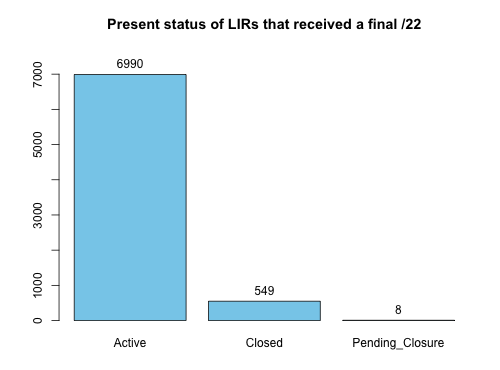
Figure 1. Present status of LIRs that received a final /22
The policy for the last /8 does not distinguish between existing LIRs who already had some IPv4 before the RIPE NCC reached the last /8 and new LIRs who joined the RIPE NCC after 14 September 2012. LIRs in both groups are entitled to one final /22 IPv4 allocation. Figure 2 shows for both groups the percentages of active LIRs who obtained their final /22 and LIRs who are still eligible for an allocation. We see that more than a third of the LIRs became members in the last three years. Of these, the vast majority (92%) have received a /22 allocation from the last /8. It's safe to assume that obtaining a last bit of IPv4 was the driving factor behind these organisations’ decision to join the RIPE NCC. For older LIRs the situation is different. In this group only 34% of LIRs requested a final /22 allocation from the last /8.
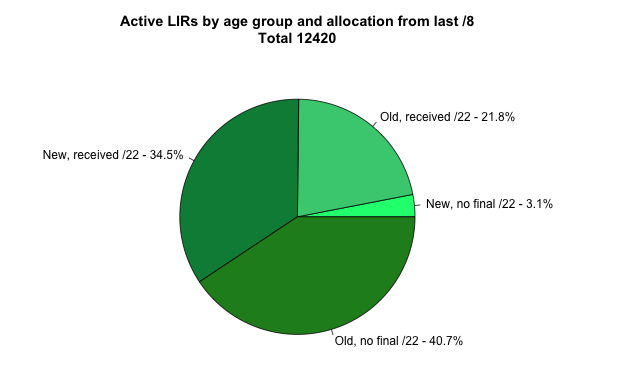
Taking a more detailed look at the age factor, we grouped LIRs by the quarter they joined the RIPE NCC and for each group calculated the percentage of LIRs that requested an allocation from the last /8. Figure 3 shows the results. For younger LIRs, the distribution is very even: starting from October 2012, at least 88% of the LIRs that joined each quarter have obtained their final /22. For older LIRs the distribution fluctuates more from quarter to quarter, but we do see that many LIRs of all ages have requested their /22 allocation from the last /8. As small as they may be, these allocations of 1,024 addresses did make a difference to these LIRs.
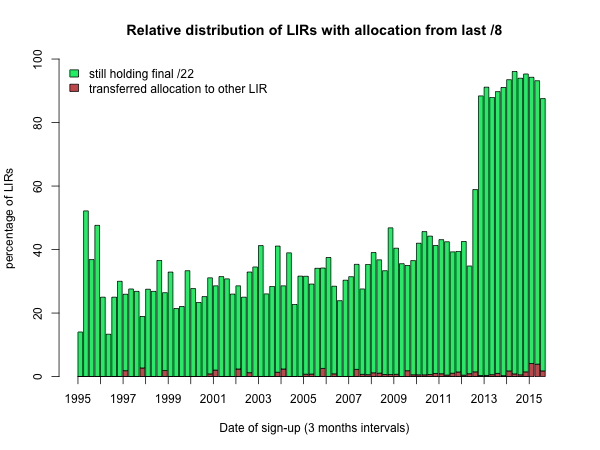
Figure 3. Relative distribution of LIRs with an allocation from the last /8
Figure 3 also shows (in red) percentages of LIRs who are still active but no longer hold an allocation from 185/8. These LIRs transferred their /22 away for one reason or another. The percentages are not very high and in absolute terms the number of LIRs involved is modest too: out of the 6,990 active LIRs that received their final allocation, only 128 no longer have it. It is interesting to see how this group is made up of LIRs of all ages, has just a slight bias to LIRs who joined recently, in the first half of 2015.
The RIPE NCC's available IPv4 pool
Since May 2012, the RIPE NCC has published daily extended statistics on the resources it manages, including those held in the free pool. These files are archived under ftp://ftp.ripe.net/pub/stats/ripencc (one folder per year). Summing up the size of all blocks marked "available" for each day produces a series of data points that shows how the RIPE NCC's available pool of IPv4 addresses evolved over time. Similarly, we can create a time series of the amount of IPv4 space allocated from the last /8, by adding up all allocations from 185/8 found in each of the statistics files. Figure 4 shows the two series together in one plot.
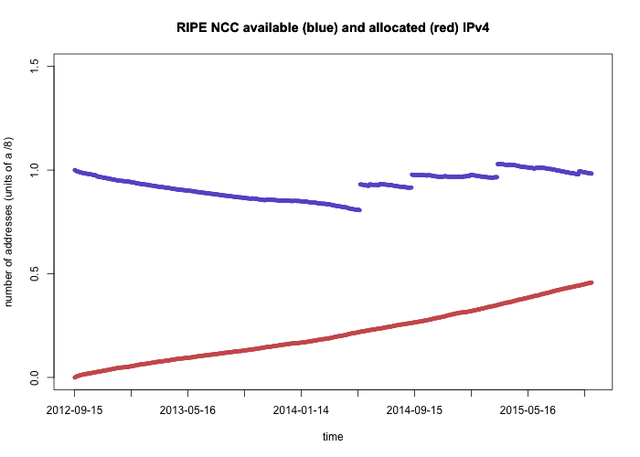
In the first year, from September 2012 to September 2013, the available pool was decreasing at the same rate allocations were being made from the last /8. In the months after this, the rate of decrease slowed down with respect to the allocation rate as deregistered addresses from closed LIRs were added to the pool of available addresses.
In May 2014, September 2014, March 2015 and September 2015, we see discrete events that increase the pool size instantly. These correspond to allocations from the IANA recovered poo l, which contains address space returned by the RIRs after the last /8s were distributed in early 2011.
The Future
As illustrated by Figure 5, the net allocation rate of IPv4 addresses in the last 12 months is described reasonably well by a linear model. The best fit yields an average rate of 8.5 /22s allocated per day. If this rate remains unchanged for the years to come, the 16.5 million addresses which RIPE NCC had available for allocation on 1 October 2015 will last until January 2021.
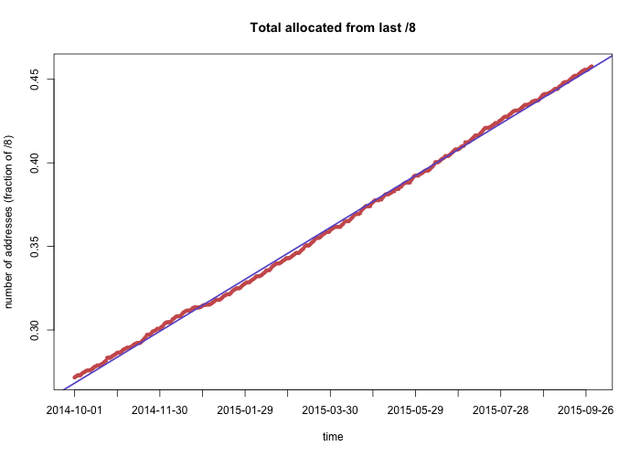
Next to the immediately available addresses, the RIPE NCC IPv4 pool also holds addresses marked as reserved. This reserve consists of both addresses that have been set aside for special purposes (a /13 for temporary assignments and a /16 for unforeseen circumstances) and addresses that were deregistered but are not yet available for reallocation (because the quarantine period has not yet expired). Of the 1.25 million reserved addresses (at 1 October 2015) 678,304 will be reallocated to LIRs in due time. At the present allocation rate, this would push full depletion of the RIPE NCC's IPv4 pool back by about three months, to April 2021.
Unlike in the last three years, we cannot expect any significant number of addresses to be added to the available pool. After four rounds of allocations, the IANA recovered pool is drying up. On 1 October 2015, only 817,408 addresses were left for redistribution. Divided between the five RIRs, this translates to just 638 /24s left to be allocated from IANA to the RIPE NCC. With the present policy and allocation rate, this amount will last only three weeks, and is just about enough for 159 LIRs to receive a final /22 allocation. Note that these addresses will not be released by IANA at once. The global policy which governs the allocation mechanisms makes that the addresses get distributed to the RIRs in ever smaller amounts at six-month intervals. If no additional addresses are returned to IANA, the last allocation from the recovered pool, a /23 for each RIR, will be made in March 2019, as presented by Elise Gerich at the recent LACNIC 24 meeting .
Since we don't expect any significant amounts of IPv4 to return to the RIPE NCC from (closed) LIRs, we are looking at a lifetime of about five and a half years for the remaining addresses if the present allocation rate and allocation policy remain unchanged.
Of course, five years is a long time. It's unlikely that, even with unchanged policy, the allocation rate will remain constant, though how it will change is impossible to predict. It could be that the need for small blocks of IPv4 shrinks when more providers deploy IPv6. It could also be that accelerated growth in LIRs joining the RIPE NCC and requesting final IPv4 allocations changes the allocation rate to be faster than linear; this would shorten the lifetime significantly. Whichever it will be, only time will tell. Here at the RIPE NCC, we will continue to monitor and report on these developments.

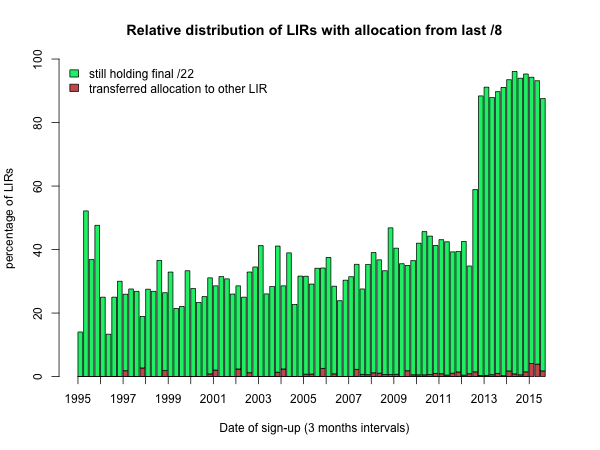

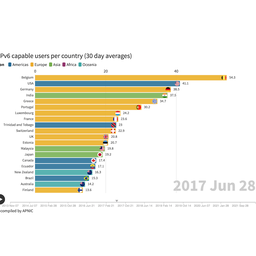
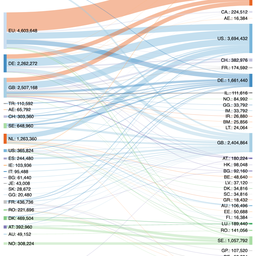
Comments 0
The comments section is closed for articles published more than a year ago. If you'd like to inform us of any issues, please contact us.